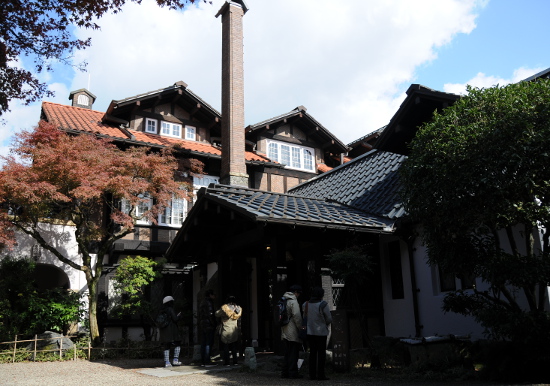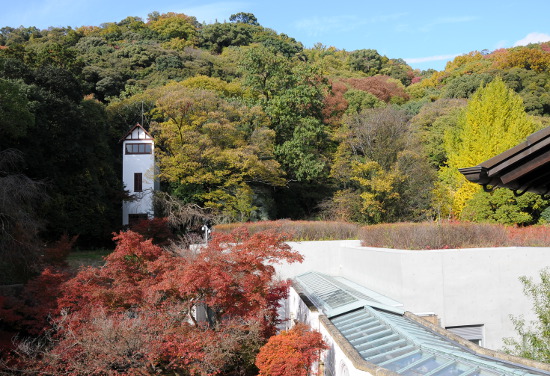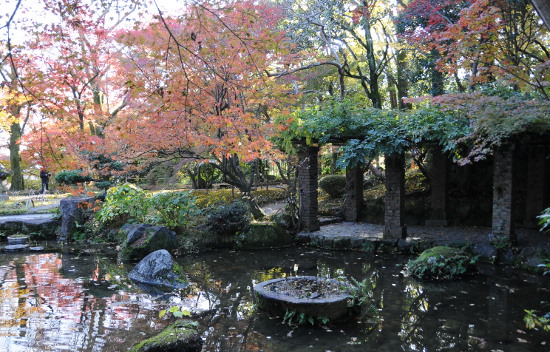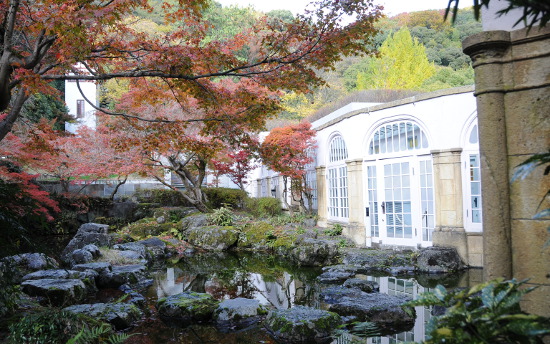Last Thursday, two friends and I took advantage of the holiday to visit Oyamazaki Sanso, or, officially: The Asahi Beer Oyamazaki Villa Museum of Art. It is located on a hillside in the south-western part of Kyoto, overlooking the place where the rivers Kizu, Uji, and Katsura merge. The villa consists of a number of buildings in a more than 16000 m2 large garden, which alone is worth a visit, in particular now.
 The main house was built in the Taisho era (about 100 years ago) and was subsequently enlarged. It has an obvious Western feeling to it, but even so, there are many features that are reminiscent of Japanese style: enormous wooden beams (one square one with a side length of 50cm) support the ceilings, and the entrance and second floor have high ceilings where the roof structure can be seen, there are little ornaments featuring bamboos… But mainly, the house is Western style: there are two large terraces on the second floor, together with a very modern looking guest bathroom with beige tiles that even features fixtures for hot water. The ground floor sports a large dining room and parlour with enormous fireplace, and out into the back, there is an airy corridor with lots of windows that once led to a greenhouse for orchids.
The main house was built in the Taisho era (about 100 years ago) and was subsequently enlarged. It has an obvious Western feeling to it, but even so, there are many features that are reminiscent of Japanese style: enormous wooden beams (one square one with a side length of 50cm) support the ceilings, and the entrance and second floor have high ceilings where the roof structure can be seen, there are little ornaments featuring bamboos… But mainly, the house is Western style: there are two large terraces on the second floor, together with a very modern looking guest bathroom with beige tiles that even features fixtures for hot water. The ground floor sports a large dining room and parlour with enormous fireplace, and out into the back, there is an airy corridor with lots of windows that once led to a greenhouse for orchids.
 This main house was built as a country villa for Shotaro Kaga, a wealthy businessman from Osaka. He had many interests, like cultivating orchids and drawing pictures of them, and he was also involved in the founding of Nikka Whisky Distilling. A close friend of his was Tamesaburo Yamamoto, the first president of the Asahi Breweries. After the death of Kaga and his wife, the house changed hands a number of times, but eventually fell into disrepair. By the mid 1980s, the house was slated for demolition to make room for luxury apartments, but the locals could convince Asahi Breweries to buy and renovate the Oyamazaki Sanso.
This main house was built as a country villa for Shotaro Kaga, a wealthy businessman from Osaka. He had many interests, like cultivating orchids and drawing pictures of them, and he was also involved in the founding of Nikka Whisky Distilling. A close friend of his was Tamesaburo Yamamoto, the first president of the Asahi Breweries. After the death of Kaga and his wife, the house changed hands a number of times, but eventually fell into disrepair. By the mid 1980s, the house was slated for demolition to make room for luxury apartments, but the locals could convince Asahi Breweries to buy and renovate the Oyamazaki Sanso.
The old buildings were renovated, and two new buildings that now serve as the main museum were added. Designed by Japanese architect Tadao Ando, they are so well integrated into the site that they are all but inconspicuous when approaching the main building. The whole museum now contains the main house, a watchtower (from where Kaga watched the main house being built), two tea houses, a rest house (originally a garage) and the modern jewelry box and dream box museum annexes. The museum opened in 1996, and the old buildings were designated as Registered Tangible Cultural Properties in 2004.
 The museum shows various special exhibitions during the year, and it also shows pieces from the Yamamoto collection of art, collected by the first president of Asahi Breweries who was interested in the Mingei Movement that focused on folk art. The underground jewelry box, a small, round single room shows parts of the permanent collection, in particular some of Monet’s Water Lilies paintings. This was quite a surprise to me, mostly because the museum is so small. I now found out that Monet had painted some 250 versions of the Water Lilies, but still, that there are three of those paintings in such a small museum is quite a feat I think.
The museum shows various special exhibitions during the year, and it also shows pieces from the Yamamoto collection of art, collected by the first president of Asahi Breweries who was interested in the Mingei Movement that focused on folk art. The underground jewelry box, a small, round single room shows parts of the permanent collection, in particular some of Monet’s Water Lilies paintings. This was quite a surprise to me, mostly because the museum is so small. I now found out that Monet had painted some 250 versions of the Water Lilies, but still, that there are three of those paintings in such a small museum is quite a feat I think.
 As mentioned above, the museum lies in an enormous garden on a hillside. Especially now during the koyo, the garden is lovely – and it can be visited for free, by the way! Of course there are the obligatory Japanese lanterns and little bridges over the water, and right next to the entrance to the jewely box with the Water Lilies paintings there is – a waterlily pond. The pond with the carp next to the corridor that once led to the greenhouse was my personal favourite spot.
As mentioned above, the museum lies in an enormous garden on a hillside. Especially now during the koyo, the garden is lovely – and it can be visited for free, by the way! Of course there are the obligatory Japanese lanterns and little bridges over the water, and right next to the entrance to the jewely box with the Water Lilies paintings there is – a waterlily pond. The pond with the carp next to the corridor that once led to the greenhouse was my personal favourite spot.
 Unfortunately, it was not allowed to take photos inside the building. There are beautiful ones on the homepage of the Asahi Beer Oyamazaki Villa Museum of Art’s homepage though, including a video and lots and lots of information about the building, the collection, the location… Do check it out, it’s worth it:
Unfortunately, it was not allowed to take photos inside the building. There are beautiful ones on the homepage of the Asahi Beer Oyamazaki Villa Museum of Art’s homepage though, including a video and lots and lots of information about the building, the collection, the location… Do check it out, it’s worth it:
http://www.asahibeer-oyamazaki.com/english
